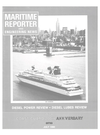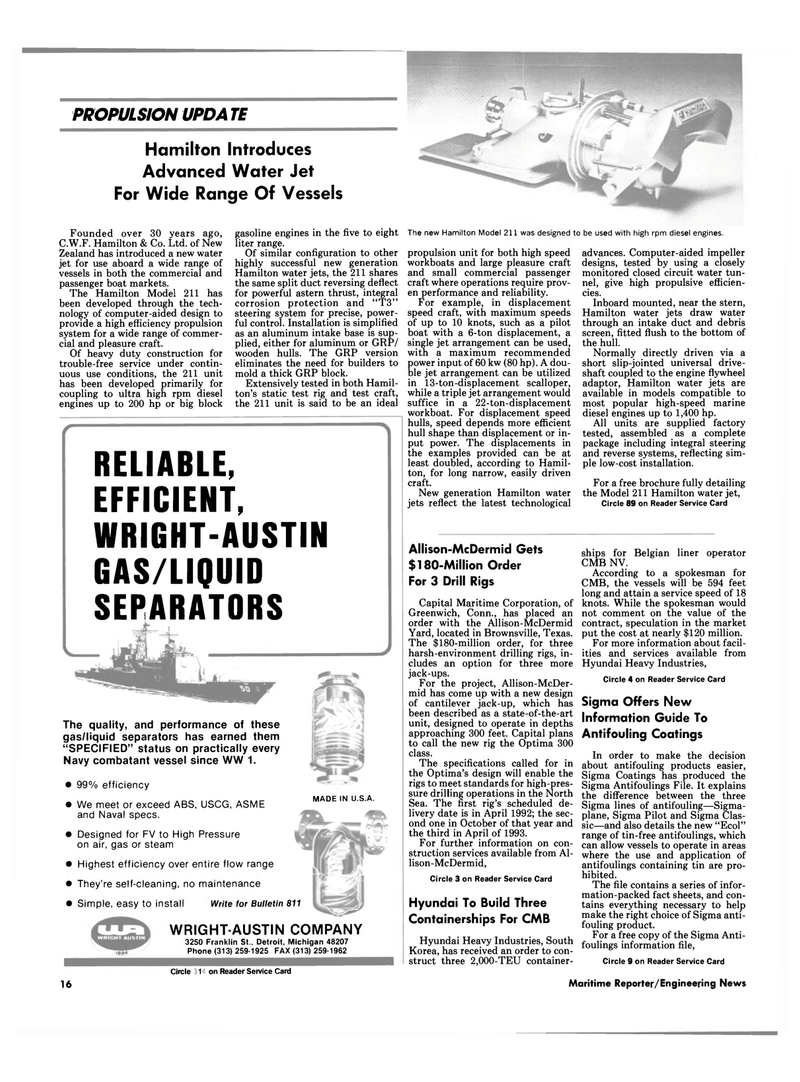
Page 15: of Maritime Reporter Magazine (July 1990)
Read this page in Pdf, Flash or Html5 edition of July 1990 Maritime Reporter Magazine
PROPULSION UPDA TE
Hamilton Introduces
Advanced Water Jet
For Wide Range Of Vessels
Founded over 30 years ago,
C.W.F. Hamilton & Co. Ltd. of New
Zealand has introduced a new water jet for use aboard a wide range of vessels in both the commercial and passenger boat markets.
The Hamilton Model 211 has been developed through the tech- nology of computer-aided design to provide a high efficiency propulsion system for a wide range of commer- cial and pleasure craft.
Of heavy duty construction for trouble-free service under contin- uous use conditions, the 211 unit has been developed primarily for coupling to ultra high rpm diesel engines up to 200 hp or big block
RELIABLE,
EFFICIENT,
WRIGHT-AUSTIN
GAS/LIQUID
SEPARATORS
The quality, and performance of these gas/liquid separators has earned them "SPECIFIED" status on practically every
Navy combatant vessel since WW 1. • 99% efficiency • We meet or exceed ABS, USCG, ASME and Naval specs. • Designed for FV to High Pressure on air, gas or steam • Highest efficiency over entire flow range • They're self-cleaning, no maintenance • Simple, easy to install Write for Bulletin 811
MADE IN U.S.A.
WRIGHT-AUSTIN COMPANY 3250 Franklin St., Detroit, Michigan 48207
Phone (313) 259-1925 FAX (313) 259-1962 gasoline engines in the five to eight liter range.
Of similar configuration to other highly successful new generation
Hamilton water jets, the 211 shares the same split duct reversing deflect for powerful astern thrust, integral corrosion protection and "T3" steering system for precise, power- ful control. Installation is simplified as an aluminum intake base is sup- plied, either for aluminum or GRP/ wooden hulls. The GRP version eliminates the need for builders to mold a thick GRP block.
Extensively tested in both Hamil- ton's static test rig and test craft, the 211 unit is said to be an ideal
The new Hamilton Model 211 was designed to be used with high rpm diesel engines. propulsion unit for both high speed workboats and large pleasure craft and small commercial passenger craft where operations require prov- en performance and reliability.
For example, in displacement speed craft, with maximum speeds of up to 10 knots, such as a pilot boat with a 6-ton displacement, a single jet arrangement can be used, with a maximum recommended power input of 60 kw (80 hp). A dou- ble jet arrangement can be utilized in 13-ton-displacement scalloper, while a triple jet arrangement would suffice in a 22-ton-displacement workboat. For displacement speed hulls, speed depends more efficient hull shape than displacement or in- put power. The displacements in the examples provided can be at least doubled, according to Hamil- ton, for long narrow, easily driven craft.
New generation Hamilton water jets reflect the latest technological advances. Computer-aided impeller designs, tested by using a closely monitored closed circuit water tun- nel, give high propulsive efficien- cies.
Inboard mounted, near the stern,
Hamilton water jets draw water through an intake duct and debris screen, fitted flush to the bottom of the hull.
Normally directly driven via a short slip-jointed universal drive- shaft coupled to the engine flywheel adaptor, Hamilton water jets are available in models compatible to most popular high-speed marine diesel engines up to 1,400 hp.
All units are supplied factory tested, assembled as a complete package including integral steering and reverse systems, reflecting sim- ple low-cost installation.
For a free brochure fully detailing the Model 211 Hamilton water jet,
Circle 89 on Reader Service Card
Allison-McDermid Gets $180-Million Order
For 3 Drill Rigs
Capital Maritime Corporation, of
Greenwich, Conn., has placed an order with the Allison-McDermid
Yard, located in Brownsville, Texas.
The $180-million order, for three harsh-environment drilling rigs, in- cludes an option for three more jack-ups.
For the project, Allison-McDer- mid has come up with a new design of cantilever jack-up, which has been described as a state-of-the-art unit, designed to operate in depths approaching 300 feet. Capital plans to call the new rig the Optima 300 class.
The specifications called for in the Optima's design will enable the rigs to meet standards for high-pres- sure drilling operations in the North
Sea. The first rig's scheduled de- livery date is in April 1992; the sec- ond one in October of that year and the third in April of 1993.
For further information on con- struction services available from Al- lison-McDermid,
Circle 3 on Reader Service Card
Hyundai To Build Three
Containerships For CMB
Hyundai Heavy Industries, South
Korea, has received an order to con- struct three 2,000-TEU container- ships for Belgian liner operator
CMB NV.
According to a spokesman for
CMB, the vessels will be 594 feet long and attain a service speed of 18 knots. While the spokesman would not comment on the value of the contract, speculation in the market put the cost at nearly $120 million.
For more information about facil- ities and services available from
Hyundai Heavy Industries,
Circle 4 on Reader Service Card
Sigma Offers New
Information Guide To
Antifouling Coatings
In order to make the decision about antifouling products easier,
Sigma Coatings has produced the
Sigma Antifoulings File. It explains the difference between the three
Sigma lines of antifouling—Sigma- plane, Sigma Pilot and Sigma Clas- sic—and also details the new "Ecol" range of tin-free antifoulings, which can allow vessels to operate in areas where the use and application of antifoulings containing tin are pro- hibited.
The file contains a series of infor- mation-packed fact sheets, and con- tains everything necessary to help make the right choice of Sigma anti- fouling product.
For a free copy of the Sigma Anti- foulings information file,
Circle 9 on Reader Service Card
Circle 201 on Reader Service Card 16 Maritime Reporter/Engineering News

 14
14

 16
16
